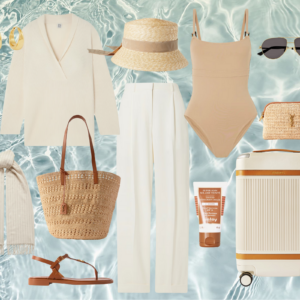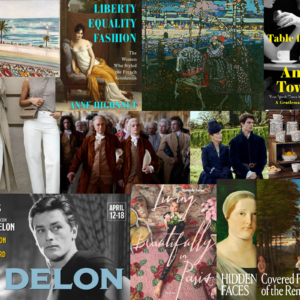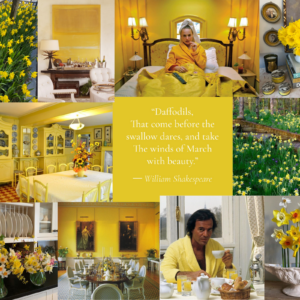24 Place des Vosges: The Amazing Home in the Film France
by habituallychic
02 . 11 . 22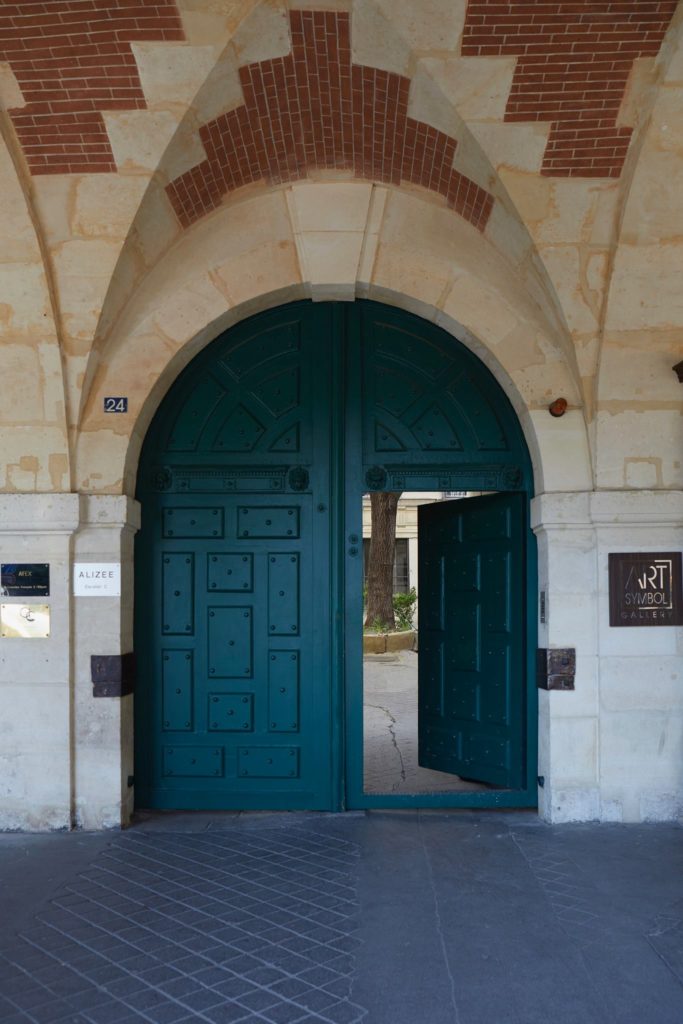
It’s a truth universally acknowledged that you never know what might be behind those large wooden doors in Paris. The last time I stayed in the City of Light, I rented an apartment at 8 rue du Pas de la Mule which happens to sit right next door to 24 Place des Vosges, the location of the incredible home in the new film France that I posted about yesterday. This detective hunt didn’t take long to solve since I could see the park of Place des Vosges outside the windows in the film and the apartment, which is part of a larger maison, is listed for parties and event rentals online.
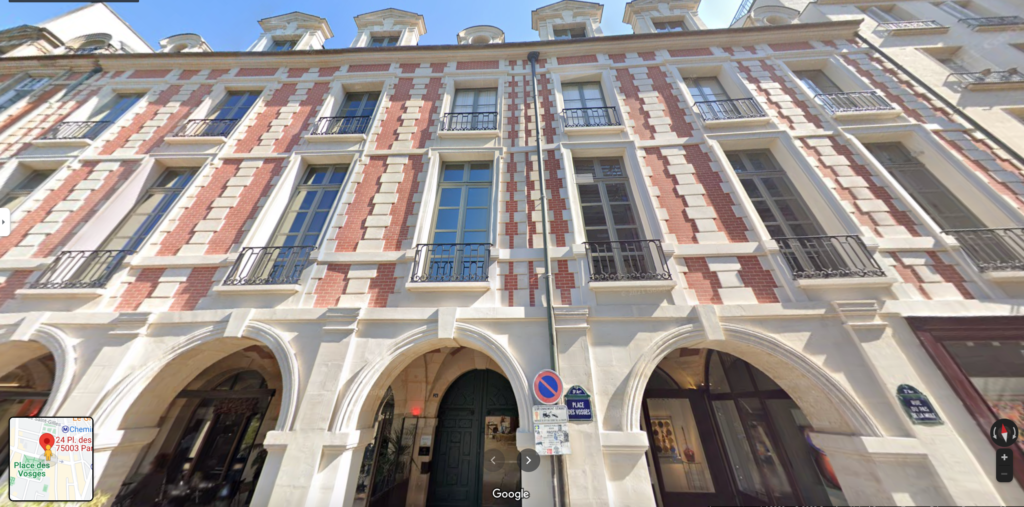
The event rental website kindly includes a floorplan (below) of the piano nobile floor. Thats’s the second floor to Americans and first floor to the French. It was how I realized that that maison spans across all seven windows of 24 Place des Vosges façade. It also runs from the basement cave space to the attics. There is a lot to cover so let’s start at the beginning.
The owner of this chic building is Jean-Claude Binoche who spent decades as an auctioneer at Drouot, the venerable French auction house. Now he is a partner of the firm Binoche et Giquello, a subdivision of Drouot, where he focuses primarily on African and pre-Columbian art. He is also a cousin of French actress Juliette Binoche.
Binoche’s building was bought by one of his ancestors during the reign of Napoleon Bonaparte, but no one from the family had ever lived there until he took an interest. The space was divided into small offices and tiny apartments that had always been rented out. “I had planned to restore the rooms to their 17th-century condition but that took some time, though.” A good forty years, to be precise. In the years before that it was time to clean up, before he could get the help of Argentinian architect Patricio Elliff in the 1980s.
When he took over the house in the early 1970s, there was a battery of office toilets on the second floor. The other floors were just as bad. Binoche gradually bought additional rooms in the backyard, which was not part of the family heritage at the time. He installed a glass elevator to avoid wasting valuable space on a stairwell. And began to give his maison the right equipment. Over the years, this has become a kind of biography of loved things. “As a teenager I was smitten with Louis XIV, later I was interested in Art Nouveau, Art Nouveau. I still think the Mathildenhöhe in Darmstadt is unique.”

The floorplan for the second floor (first floor to the French) shows how many tables it can hold for a seated dinner but also gives clues to what’s happening on this floor and the one above. The main entrance is from the stairwell in the upper right. It opens into an area that appears to have been designed with parties in mind since there two powder rooms flanking a handicapped accessible restroom. The main room overlooks the Place des Vosges and the inner building courtyard. The full building is shaped like a square doughnut. The room on the far left is a television lounge room that also overlooks the Place des Vosges. Behind it sits the kitchen which has access to an elevator and back building staircase.
It’s rare to find any buildings in Paris that are wheelchair accessible so the fact that this one has not only an elevator but also an accessible restroom is very impressive.
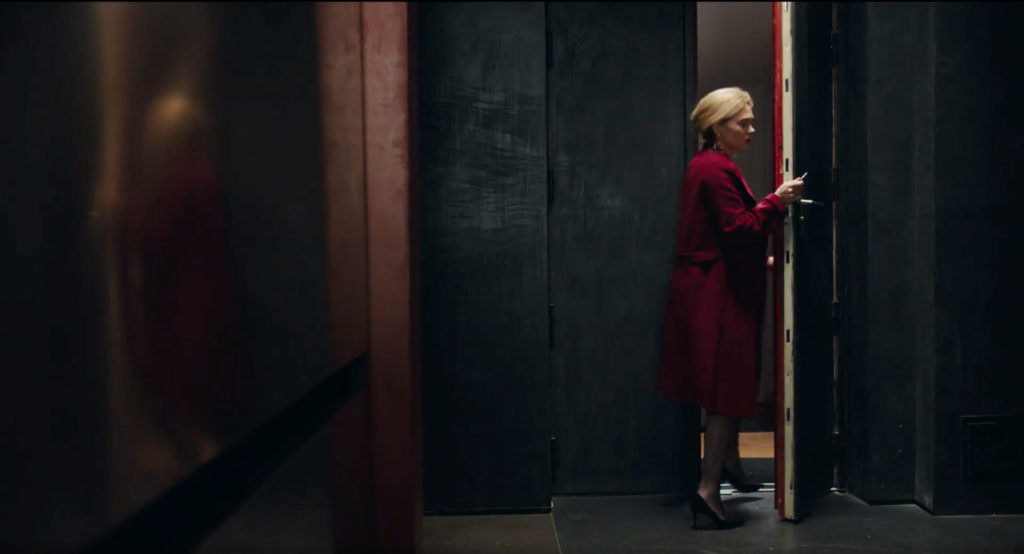
As we see in the film France, the character played by Léa Seydoux, enters into the first floor through a glossy red door. I wonder if each floor was kept self contained in case they wanted the option to sell each separately in the future and because of the event rentals. It looks like the back elevator connects each floor privately.
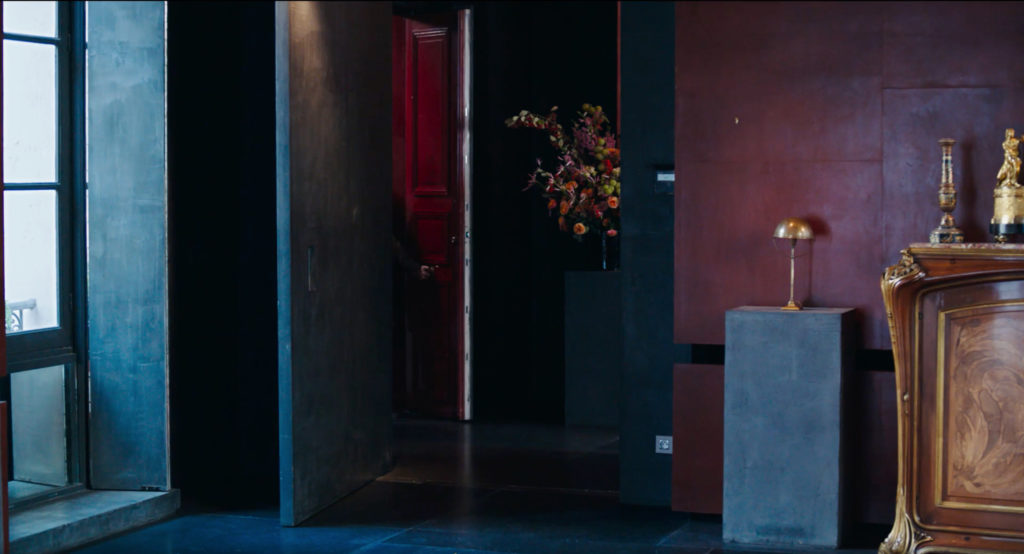
I forgot to mention in my previous post that the gorgeous flower arrangements in the film France were from Debeaulieu in Paris.
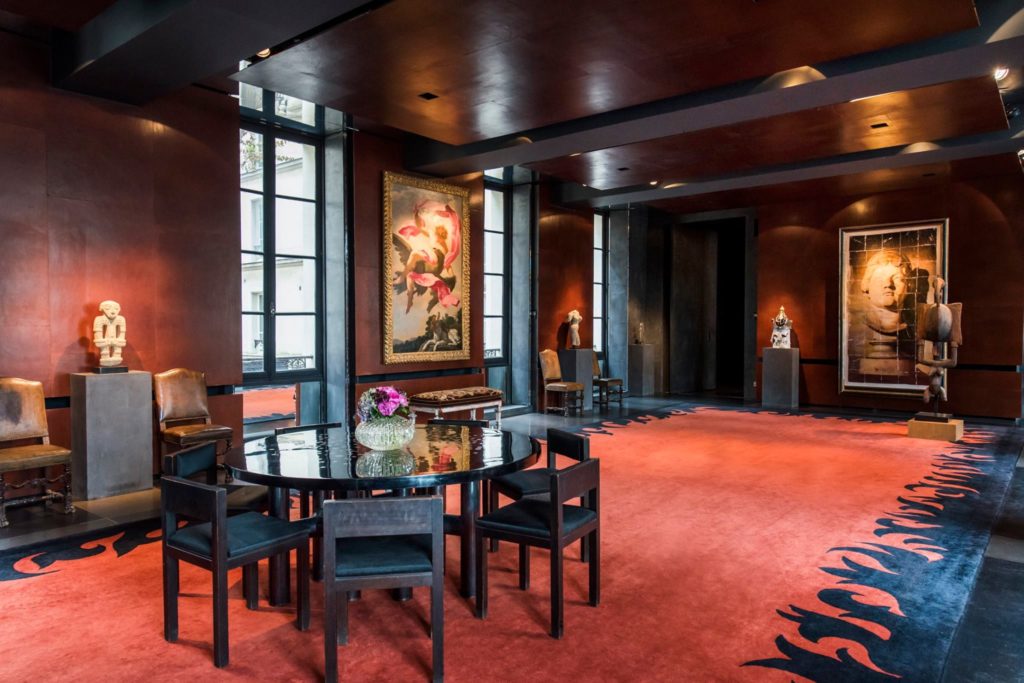
In traditional French architecture, this room would be referred to as the salon. The dining table seems to stay in the same spot but the artwork and antiques rotate often.
Jean-Claude Binoche also had the idea for the screens on the windows facing the courtyard: “I had slides of photos from the Venetian lagoon attached between the panes of glass. I like the psychedelic effect while maintaining discretion.” I wish there was a photos of this design.
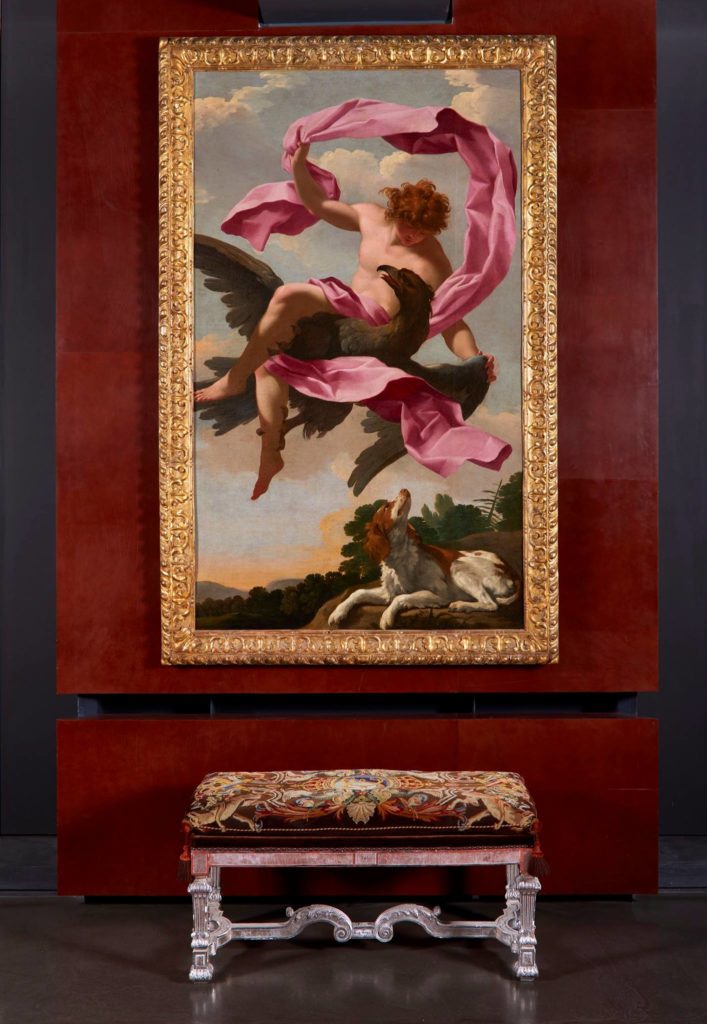
There is nothing that makes my heart sing more than antiques mixed with contemporary interiors and modern pieces. I especially love the addition of sexy pieces from the 1970s. The painting is by Eustache Le Sueur (19 November 1617 – 30 April 1655).
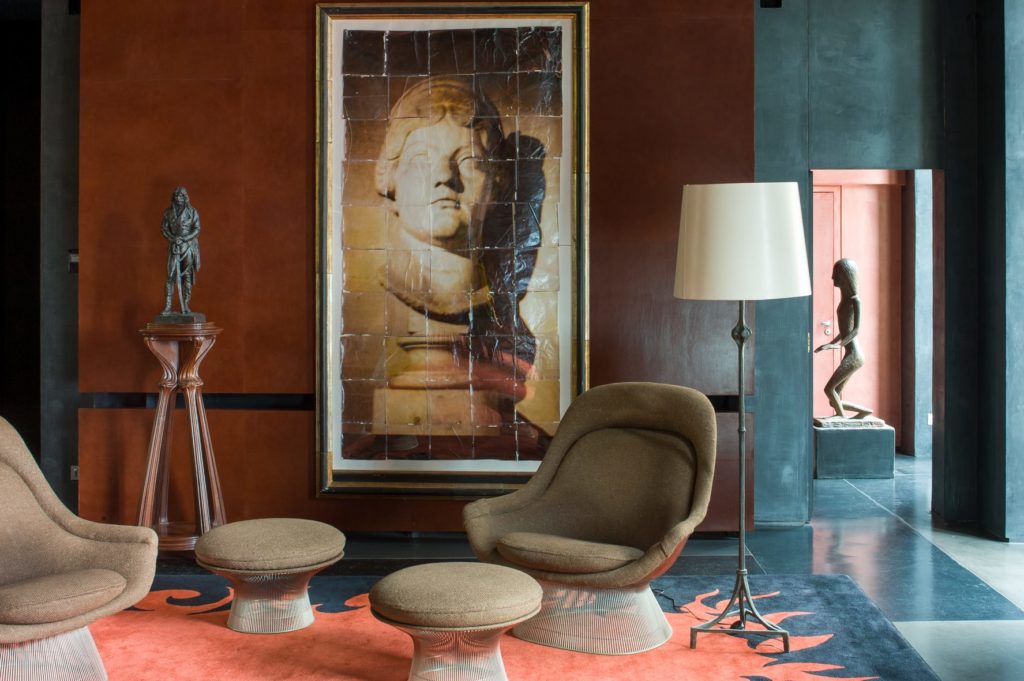
The home was featured in Architectural Digest Germany in May 2015 and in French AD in 2018 so I was find out some details after translation. Warren Platner chairs and stools from the 1960s sit in front of a painted over photograph by the Starn Brothers. The sculpture on the left is a general, Lazare Hoche, an ancestor of Jean-Claude Binoche.

The Art Nouveau cabinet moves around as well.

In the film, the Art Nouveau cabinet replaces the photograph which moved to one of the side walls. While the Debeaulieu flowers take center stage.
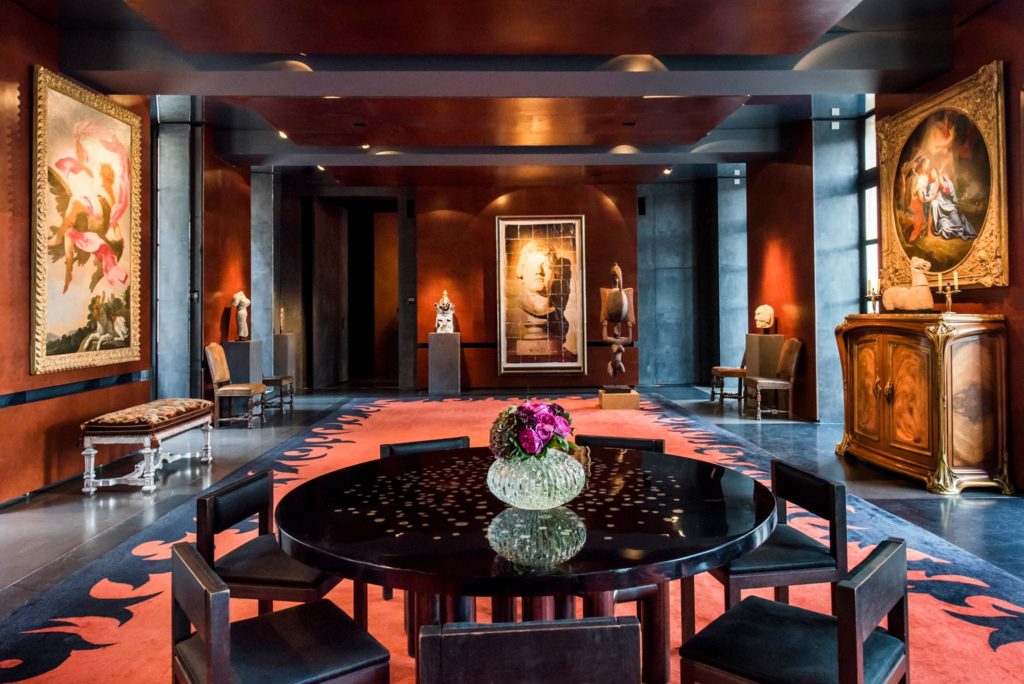
Another view of the salon with a different configuration of furniture and art.
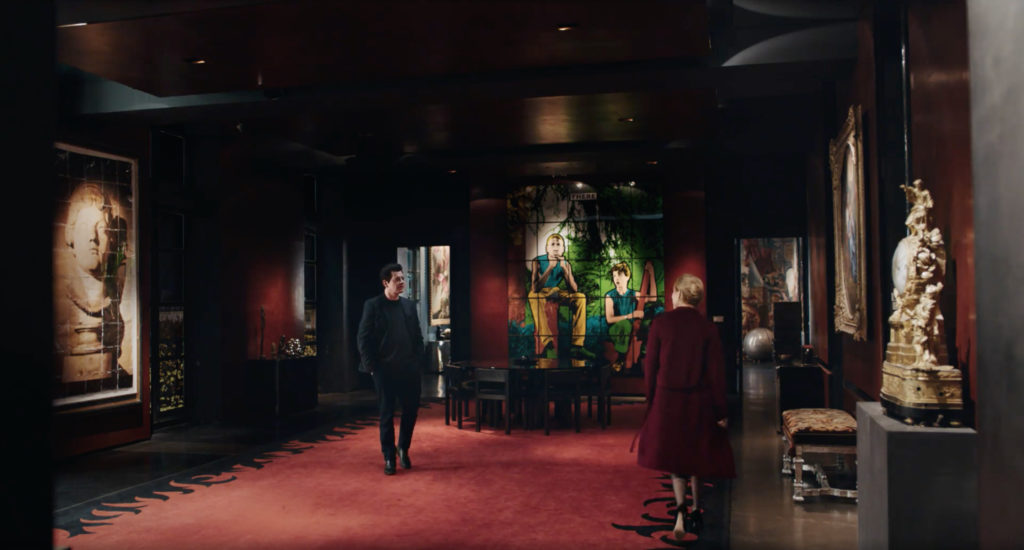
The salon seen at night during the film looks very sexy.
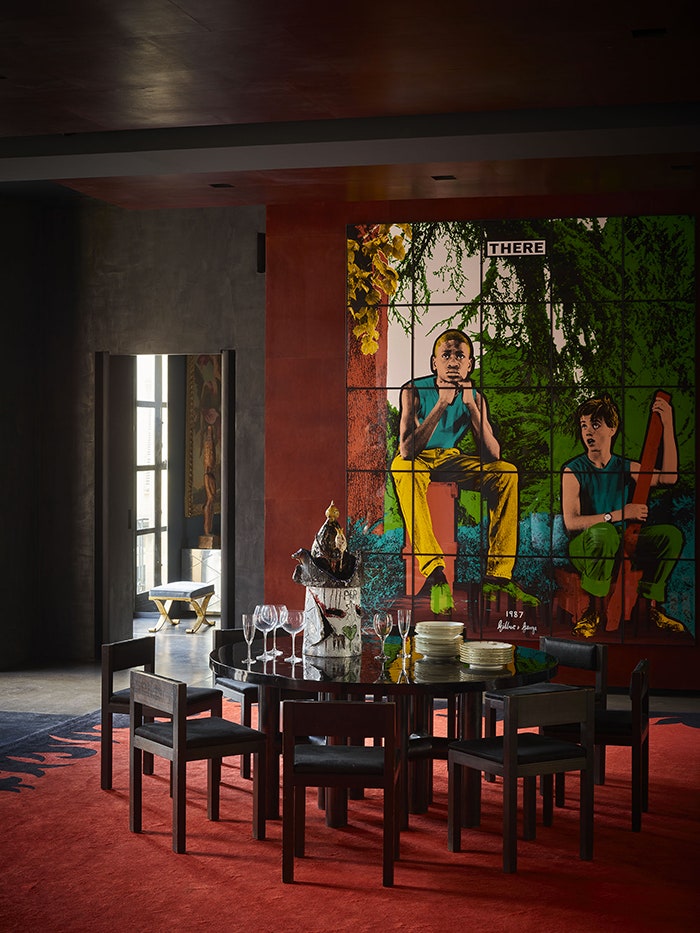
Gilbert & George’s work “There” from 1987 provides a topic of conversation during dinner parties.

Ado Chale designed the table and chairs and the horse sculpture comes from China during the Han Dynasty.
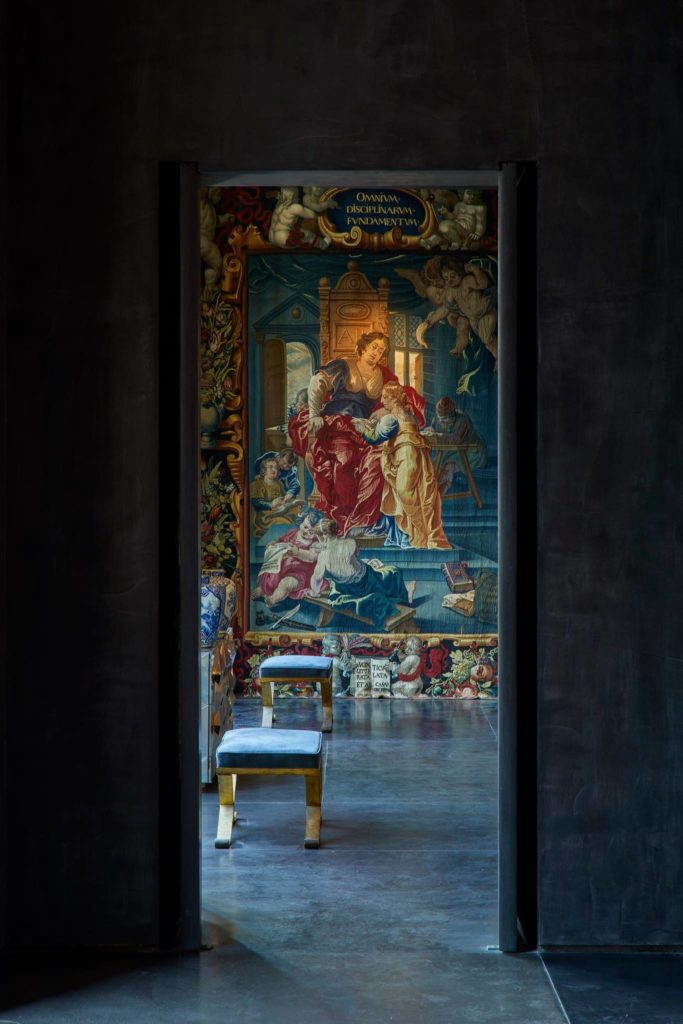
I love that each room can be closed off which probably comes in handy during events.
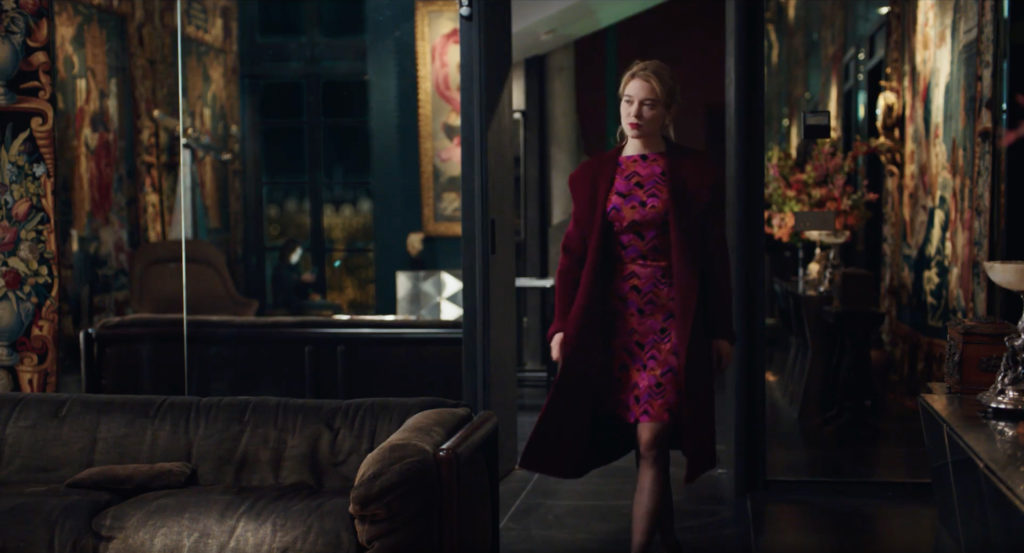
In the film, Léa Seydoux enters the tapestry lined living room. One article refers to it as 25 Place de Vosges so perhaps apartments from two neighboring buildings were combined.
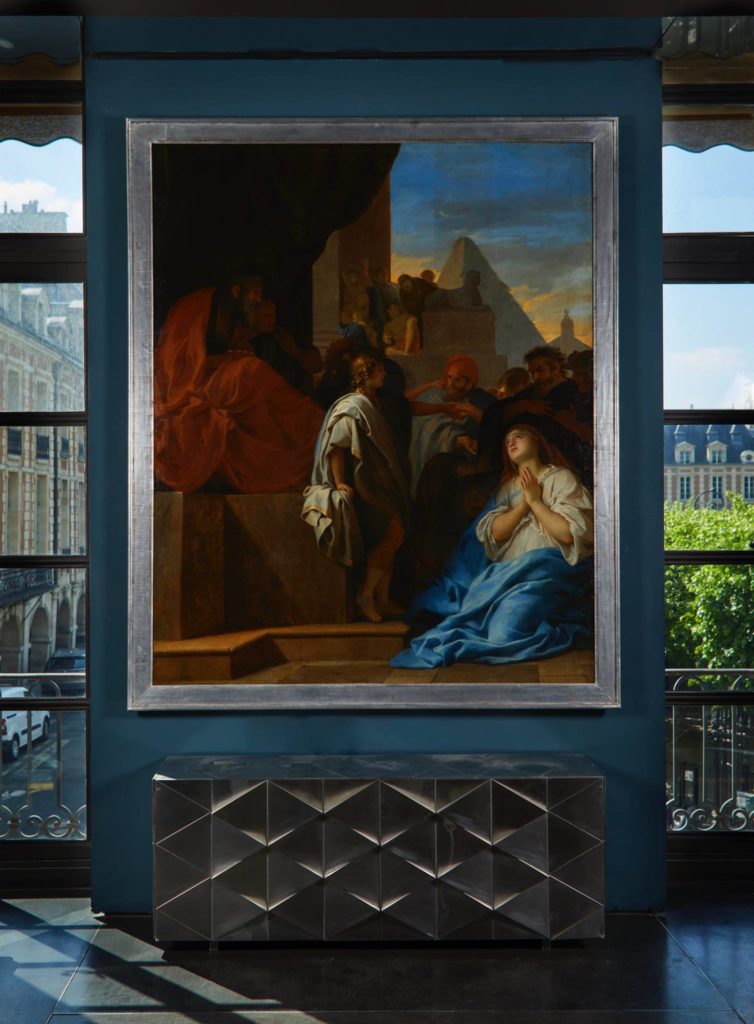
The metal sideboard by Françoise See.
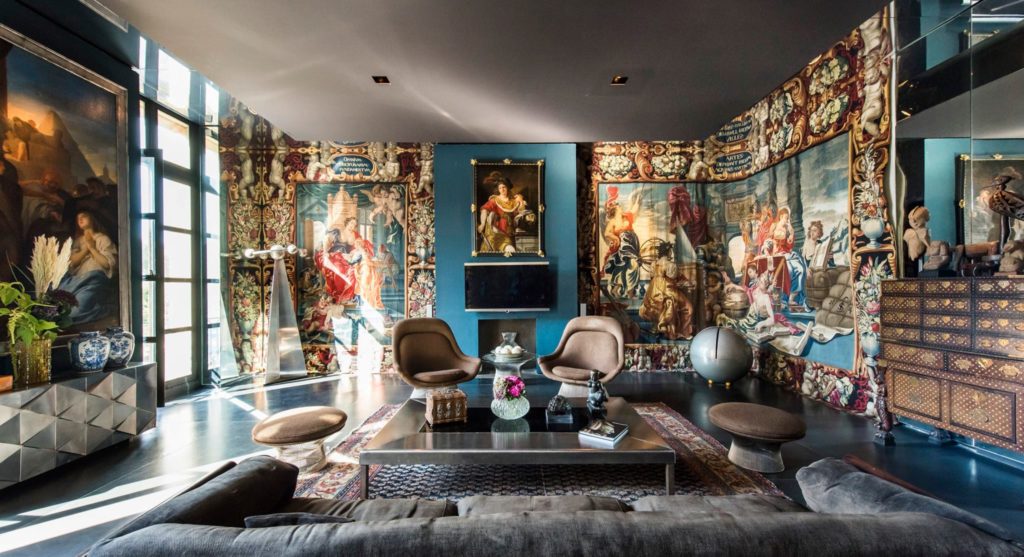
In front of the 16th century Bruges tapestry is a floor lamp in the corner is by Yonel Lebovici. The Warren Platner chairs and ottomans usually reside in this room.
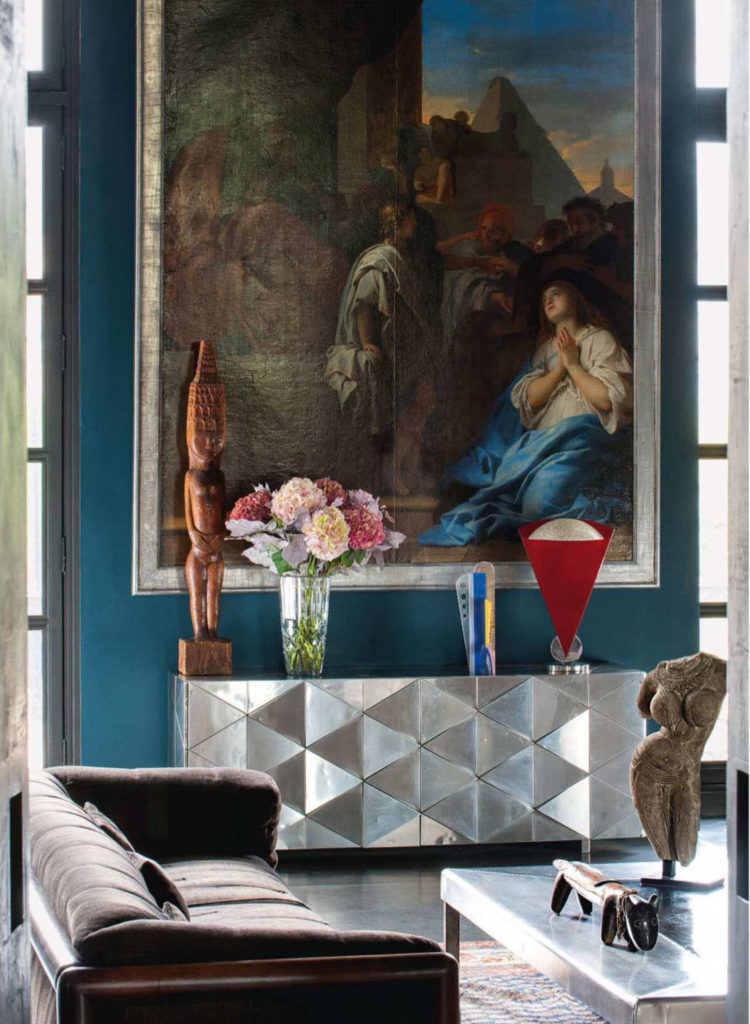
The sofa is by Tobia Scarpa but I couldn’t find another example with exact frame so I assume it’s a rare model.
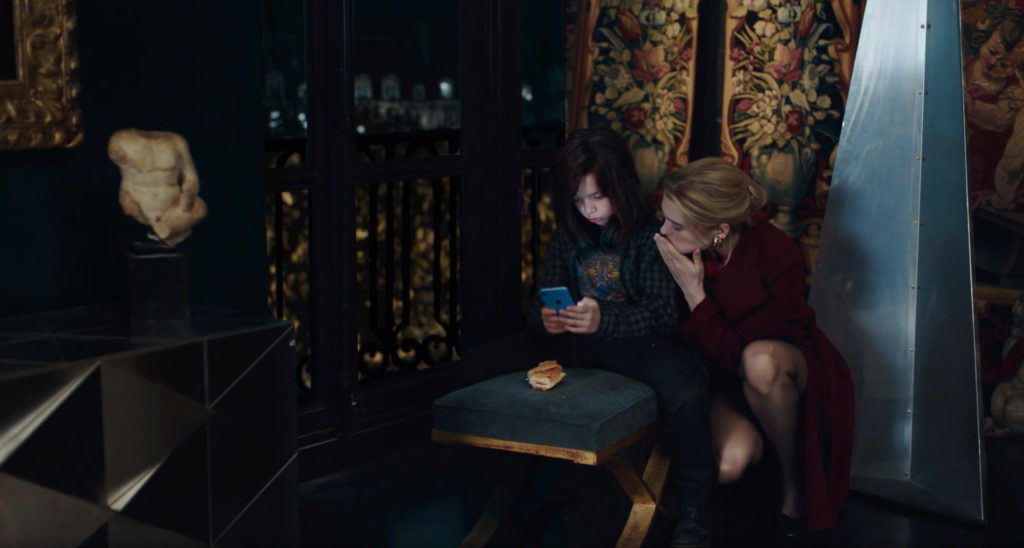
Another scene from the film, shows how many different period and styles are mixed in the living room.
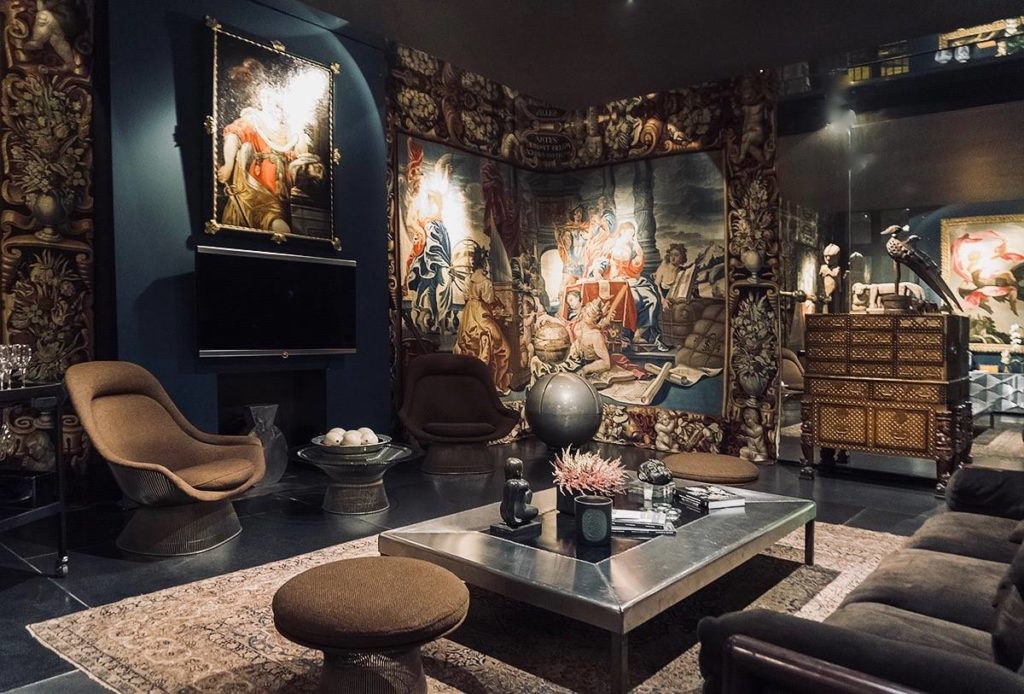
I couldn’t find a credit for the check in front of the mirror so if anyone recognizes it, please let me know.
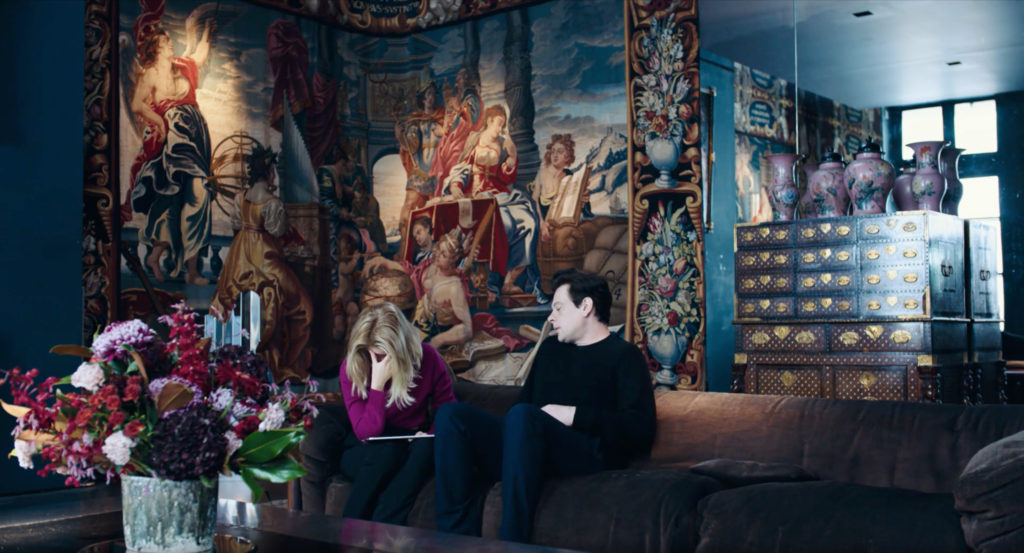
The apartment is on the north side of the Place des Vosges so it has south facing windows. The colors pop during the daytime and especially in the film France.
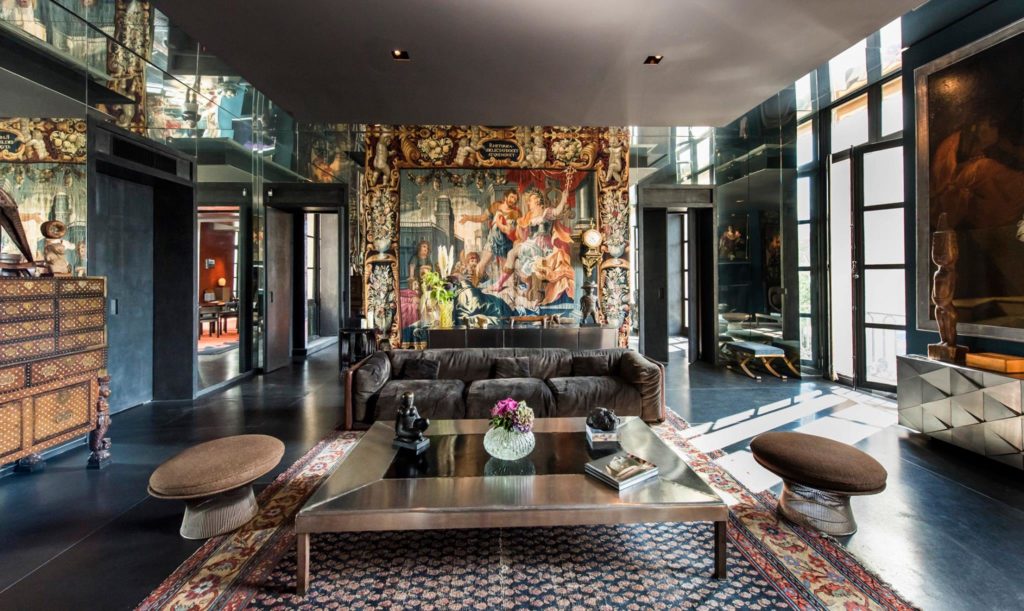
There are so many different metals and periods and styles of art and furniture mixed in this room with mirrored walls but it all works perfectly together.

As I mentioned in my previous post on the fashion of the film France, I think the costume designer did such an amazing job choosing clothing and colors that complemented the interiors of this home.
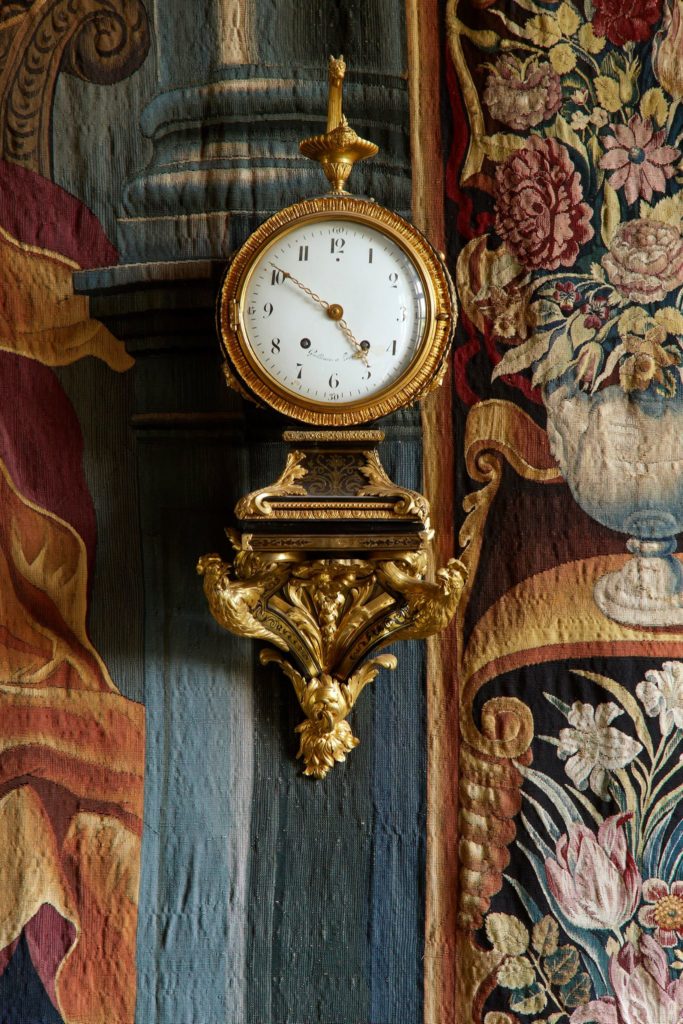
A beautiful detail of an 18th-century clock in front of the 16th-century tapestry.
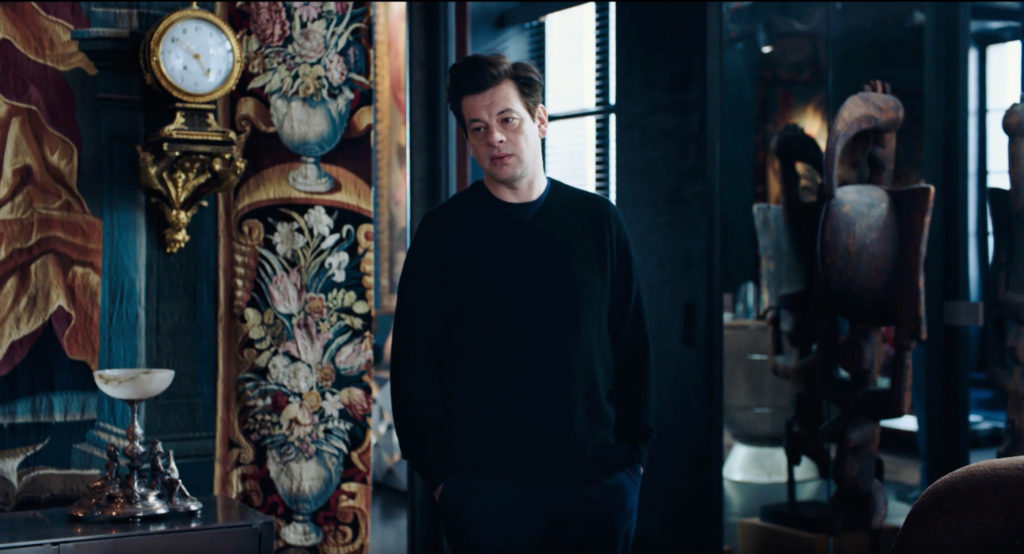
The actor who plays the husband of Léa Seydoux in the film is Benjamin Biolay, a French singer, songwriter, record producer, musician and actor. He is the ex-husband of Chiara Mastroianni, the daughter of Catherine Deneuve and Marcello Mastroianni. I wonder if he thought Léa looked like modern day Catherine Deneuve in this film as I did.

The living set for a drinks event.

The kitchen sits off the living room. There’s a wet bar behind the film couple and the full kitchen is behind the wall. The window overlooks the center courtyard.
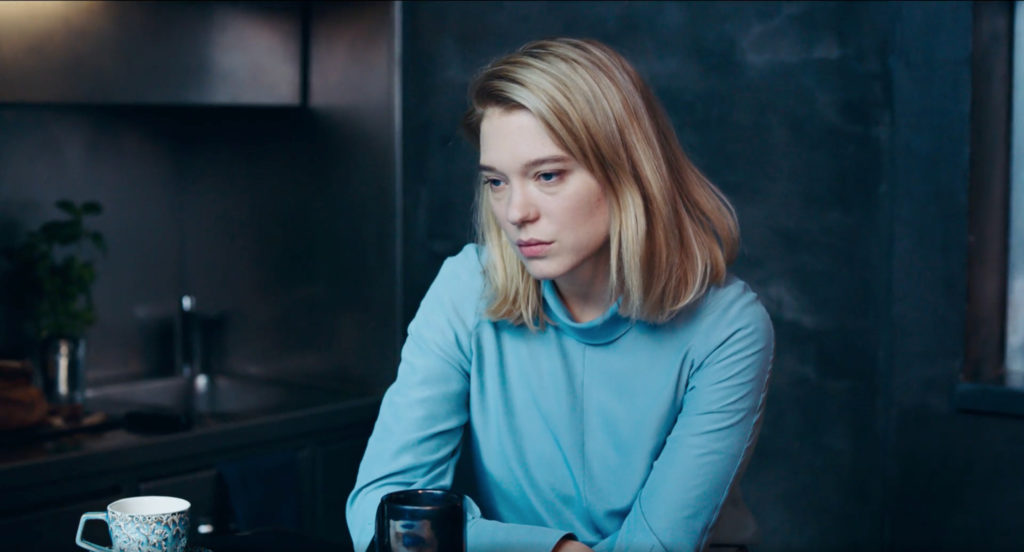
You can see the wet bar sink in the background.
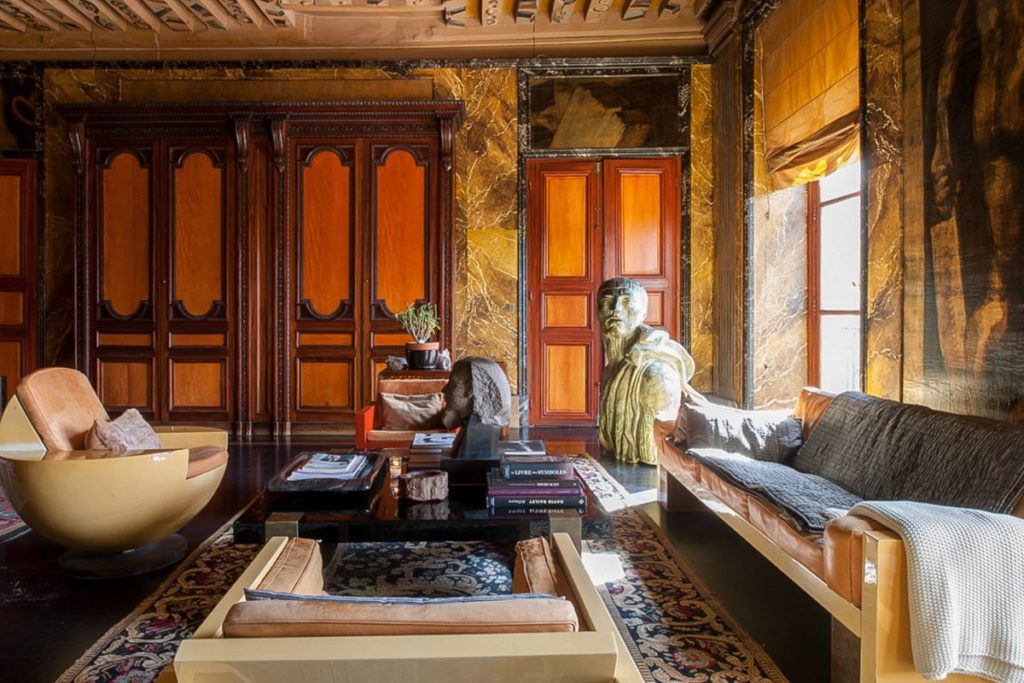
The third floor is described as the second Attic floor and this guestroom which sits above the living room below. The statue is The Eloquence by Antoine Bourdelle.

This scene from France shows the beautiful view of the Place des Vosges park. The armchair and sofa are by Serge Manzon.

The walls are decorated with murals by the Spanish surrealist Josep Maria Sert. He was famous in the 1930s for the murals he painted in the lobby of Rockefeller Center. His wife Misia was a very good friend of Coco Chanel.

Jean-Claude Binoche in the guestroom.
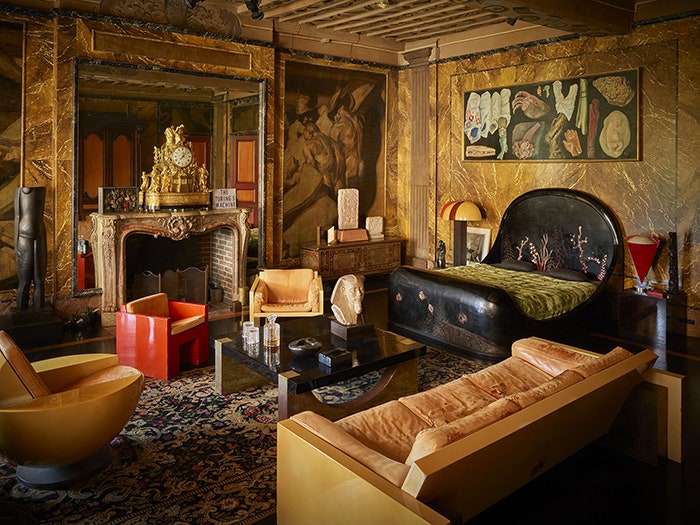
In the guestroom, the armchairs, sofas and lamps are by Serge Manzon. The lacquer bed is by Jean Dunand. On the wall, a surrealist painting by Jindřich Styrsky. In the background, on a 15th-century Venetian buffet are Aztec works.
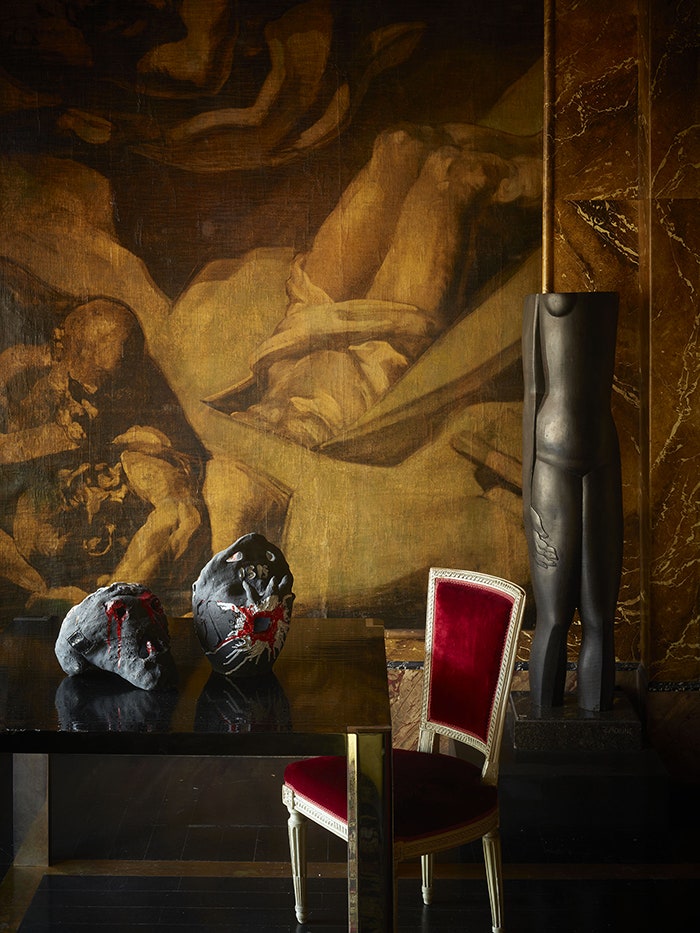
Jean-Claude Binoche owns an apartment in a historic palazzo in Venice, a country house to the north of Paris and also a small cottage in Ibiza. But the Parisian prefers to stay in his hometown. “Life here can be very pleasant,” he says. “In terms of culture, the city has an almost inexhaustible amount to offer. And people celebrate quite spontaneously here, pour un oui pour un non. You never get bored here.”
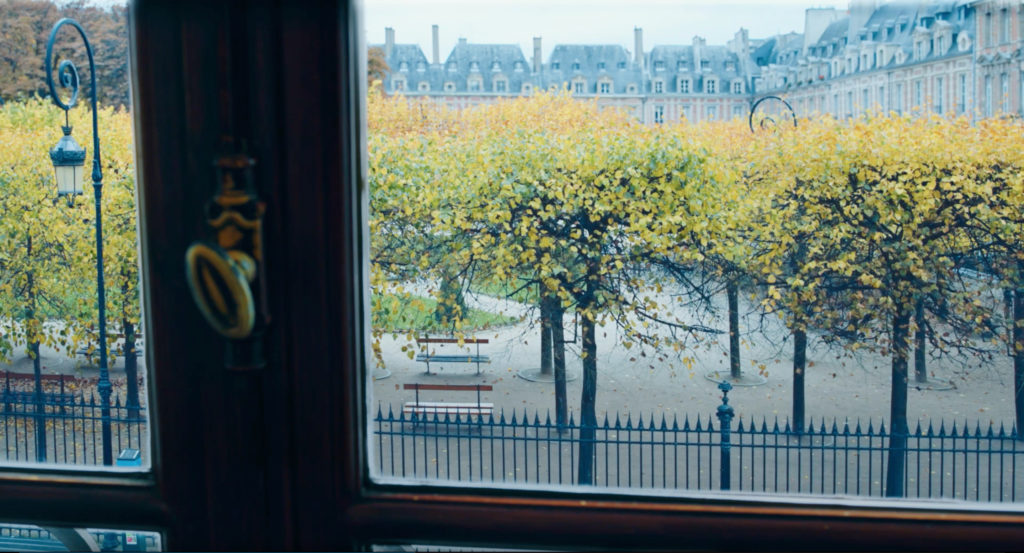
The Place de Vosges has the distinction of being the oldest square in Paris with a long and sometimes tragic history. Originally known as Place Royale, it was built by Henri IV from 1605 to 1612 on the site of the Hôtel des Tournelles and its gardens. It was at a tournament on the site in 1559 that the French king Henri II was injured so badly that he died ten days later. His grieving widow, Catherine de’ Medici, let the tournament arena fall into disrepair and moved bitterly from the Château de la Tournelle, a grand palace built in 1388 and used by the Royal Family, down the Seine to the Louvre. She also persuaded her son to demolish the Hotel Des Tournelles, where both Louis XI and Louis XII died.
In 1604, King Henry IV, commissioned the building of the Royal Pavilion. His intention was to stimulate France’s commerce, in particular the manufacturing of silk and linens, so it could compete with the craftsmen and artisans of Milan. In his vision, workers would live on the upper floors, produce their goods in factories located on the middle floors, and sell them in stores located at ground level. Unfortunately, King Henri IV never got to see the completion of his project. He died at the hands of an assassin in 1610. His son, King Louis XIII, then 11 years old, attended the inauguration of Place Royale in 1612.
What was new about the Place Royale in 1612 was that the house fronts were all built to the same design, probably by Jean Baptiste Androuet du Cerceau, of red brick with strips of stone quoins over vaulted arcades that stand on square pillars. The steeply-pitched blue slate roofs are pierced with discreet small-paned dormers above the pedimented dormers that stand upon the cornices. Only the north range was built with the vaulted ceilings that the “galleries” were meant to have. Two pavilions that rise higher than the unified roofline of the square center the north and south faces and offer access to the square through triple arches. Though they are designated the Pavilion of the King and of the Queen, no royal has ever lived in the aristocratic square, except for Anne of Austria in the Pavillon de la Reine, for a short while. (Now home to the Pavillon de la Reine hotel.) Place des Vosges initiated subsequent developments of Paris that created a suitable urban background for the French aristocracy and nobility including the Place Dauphine, additions to the Louvre Palace, the Pont Neuf, and the Hôpital Saint Louis.
In the late 18th century, while most of the nobility moved to the Faubourg Saint-Germain district, the square managed to keep some of its aristocratic owners until the Revolution. It was renamed Place des Vosges in 1799 when the département of the Vosges became the first to pay taxes supporting a campaign of the Revolutionary army.
Place de Vosges was home to many famous French people including writer Victor Hugo from 1832 to 1848. A museum now devoted to his memory is located at 6 Places de Vosges.
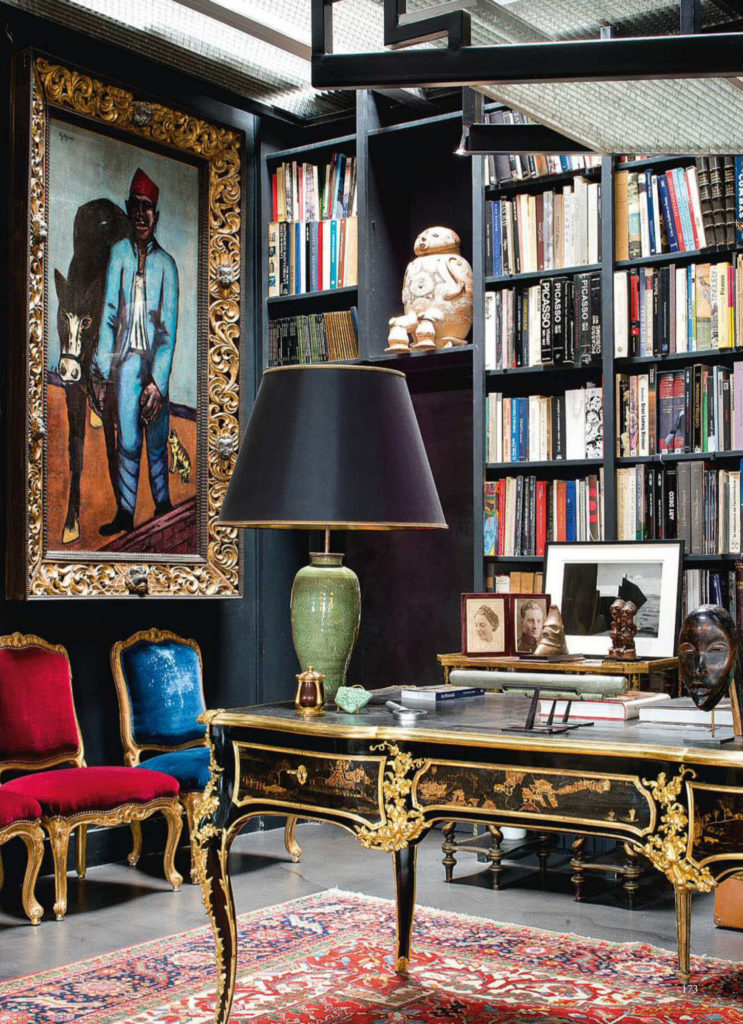
In the library, with Max Beckmann’s Negro Poilu and a thousand-year-old urn from the Amazon.

It’s unclear where the library sits on the third floor. It might be in the area above the salon and we’re just not seeing the full scale of the room.

A Tiffany lamp sits on a desk stamped Bernard Van Riesen Burgh. On the left, is a sideboard displaying a mixture of Aztec, Congolese and Easter Island sculptures.
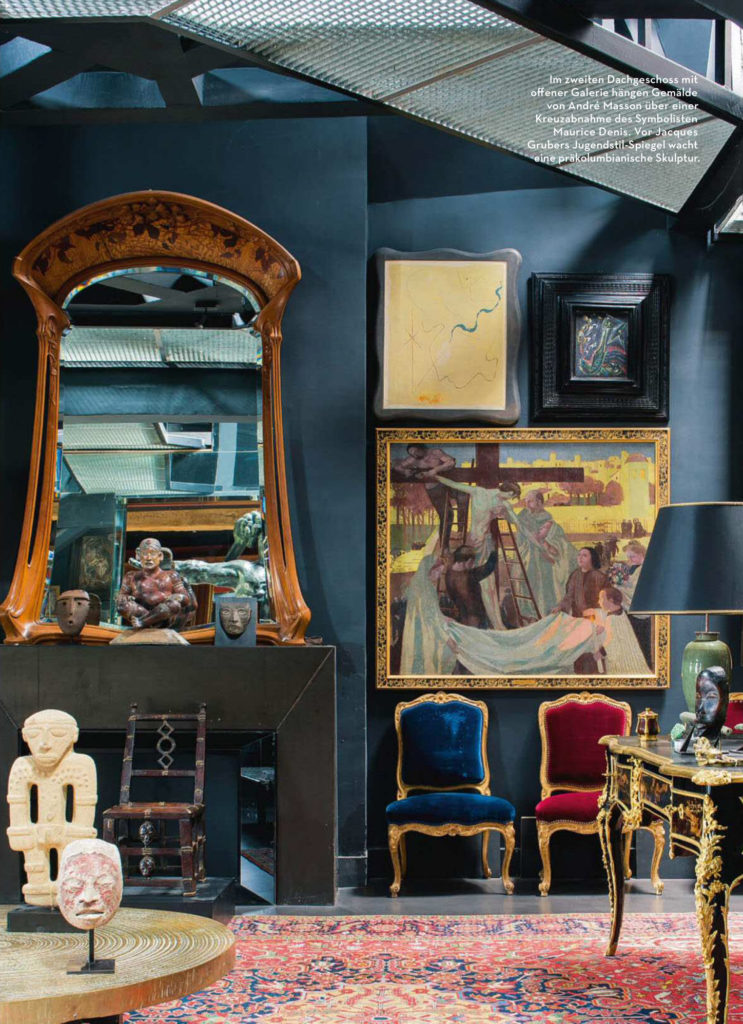
On the second attic floor with an open gallery, paintings by Andre Masson hang over a Descent from the Cross by the symbolist Maurice Dens. A pre-Columbian sculpture watches over Jacques Gruber’s Art Nouveau mirror.

“Unusual style liaisons: the master of the house shares his private rooms with a Mayan jaguar, two Ibo sculptures from Nigeria and paintings by André Masson.” You can tell this is the top floor attic level based on the round windows. This is probably where the servants were housed at some point.
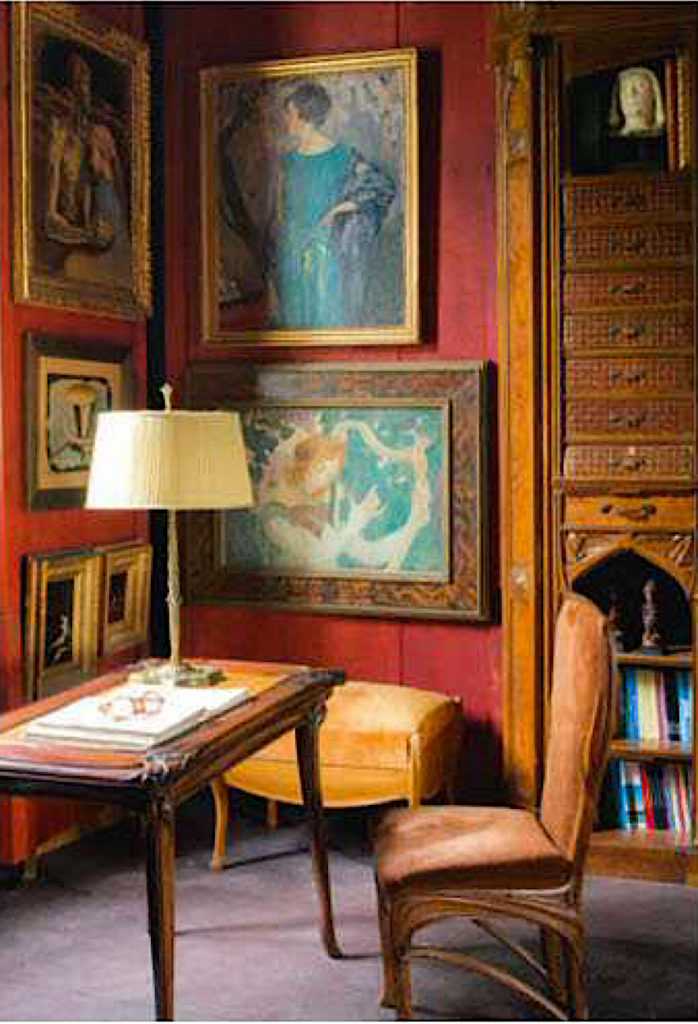
Sorry for the blurry photo but the other part of the top attic floor is red and hung with paintings by Alberto Savinio, Man Ray and Armand Point, which sit above a worktable by Eugène Gaillard.
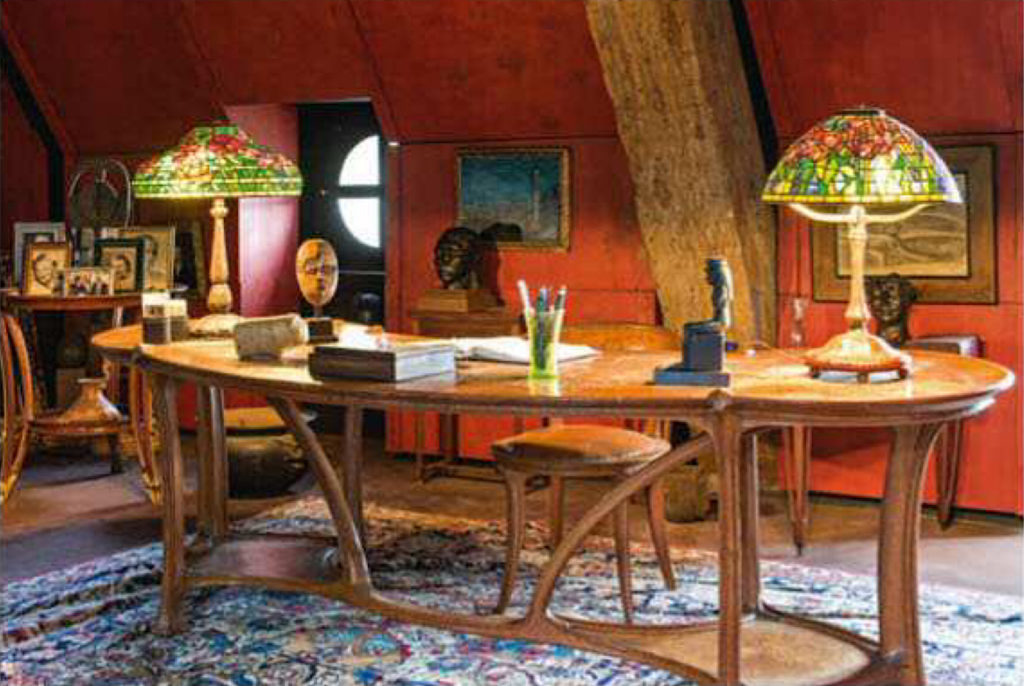
A Tiffany lamp sits on a desk by Lucien Lévy-Dhurmer.
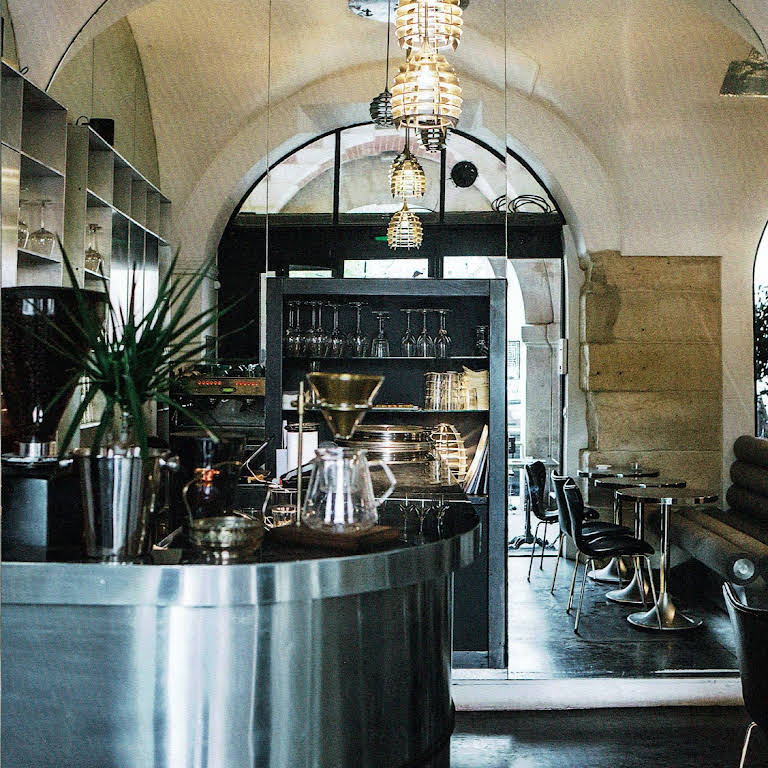
And if that wasn’t enough for you, a chance meeting with American in Paris, Alexander Keyes Rash, let to a working relationship at Drouot and then at 24 Place des Vosges.
Alexander told Les Hardis, “It was space that found me and not the other way around. There was this cellar in which the elevator descended, a little forgotten. I kept thinking that something had to be done about it. In the meantime, I was working at the Ristretto (the little Italian restaurant on the ground floor). A few years later, the neighboring art gallery vacated the premises which became available. He convinced his mentor to let him do something with all these accidents. “I persuaded him to invest in my taste, to let me bring a certain amount of magic and adventure to Place des Vosges.”
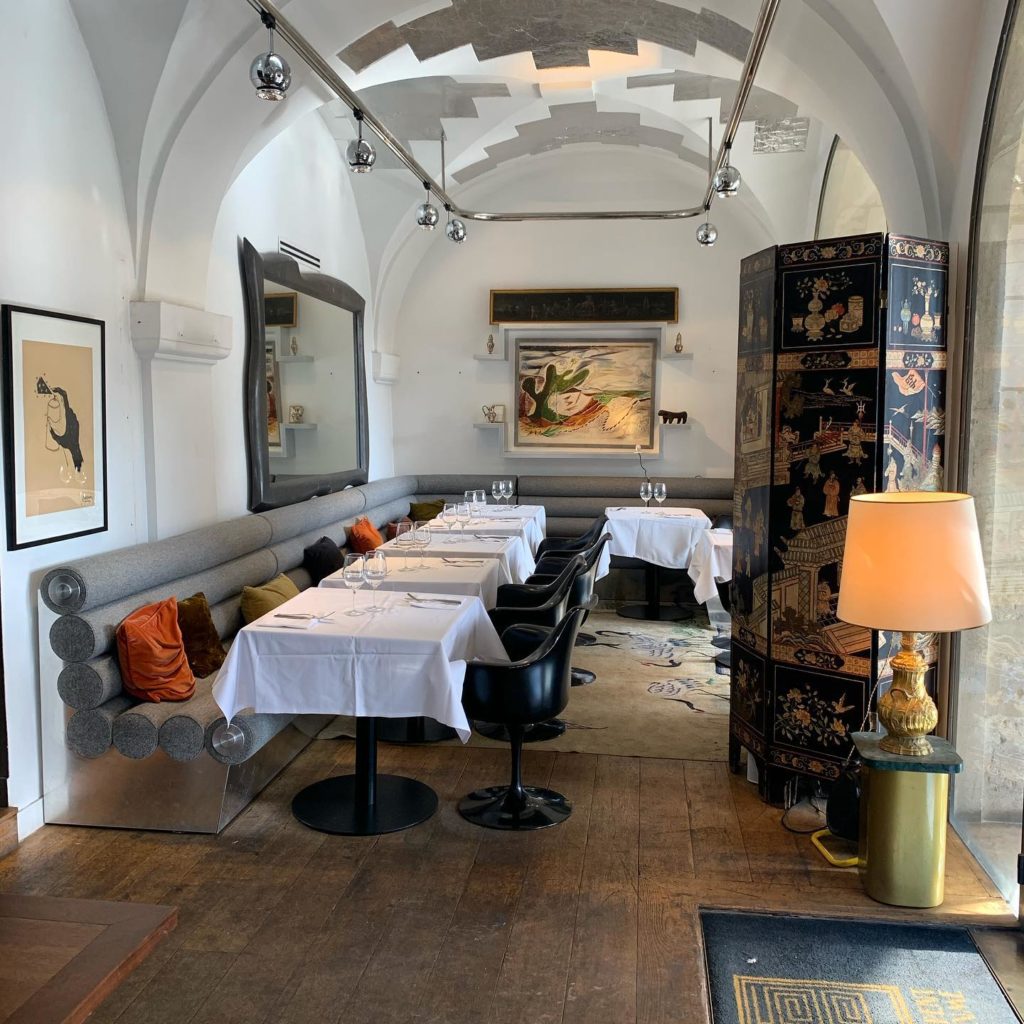
On the ground floor and in the basement, Alexander Keyes Rash opened Serpent à Plume in 2018. It is a concept store that combines a night bar, a bookstore, a men’s fashion boutique, an antiques and, at lunchtime, the restaurant with terrace. “Some evenings there are jazz concerts, other techno sets. The idea is to mix people who don’t usually meet.”

“The precious staircase in a beautiful mansion in the Marais, the sculptural staircase was made in 1981 by the Argentinian architect Patricio Elliff. Treated like a jewel, it literally shines with its golden sparkles on the parquet. The mixture of eras and gilding, between the Chinese amphora revisited in matte gold in a minimalist way, the dazzling fresco signed by the collective en avant comme avant and the gold of the sculptural staircase make up a timeless and bewitching setting.”

The library area includes built in-fitting rooms not shown.
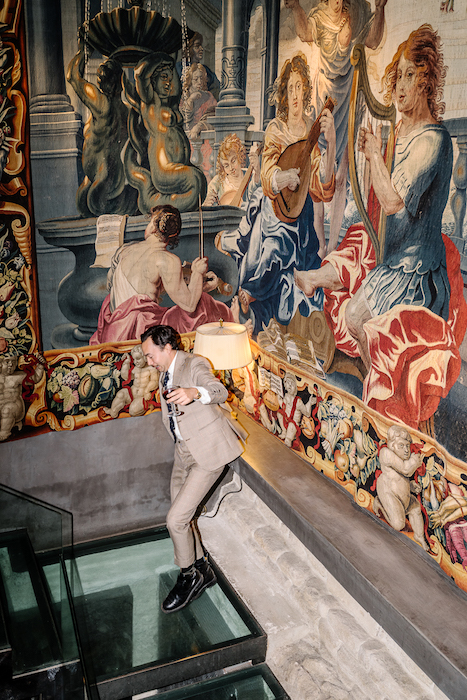
The skeleton of the place was made by an Argentinean architect, Patricio Elliff, who also created the glass staircase onto which Alex Rash jumps.

“The jacuzzi has always existed, but it was originally a fountain. When building the stairs, it was easier to keep the fountain than to destroy it. If the jacuzzi could talk, it would have stories to tell… I have two rules: the first is that you can’t come in your bathing suit. Without forcing any nudity, it should be something spontaneous. Second, there can’t be more than twenty of us in the hot tub! And that’s not too bad to start.” – Alexander Keyes Rash
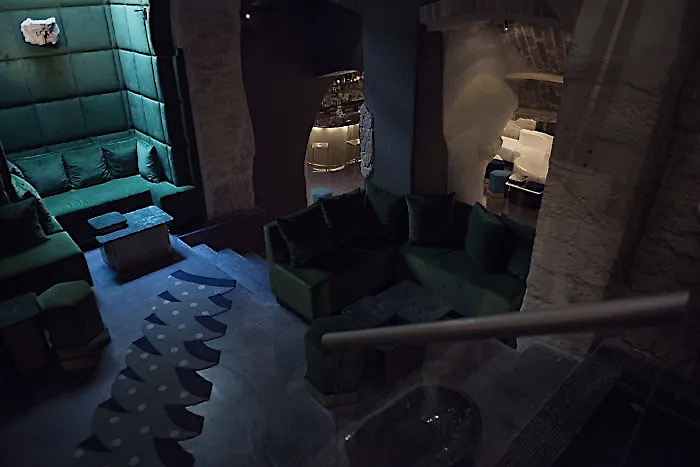
It was Vincent Darré who was called upon by Alexander Keyes Rash to set up the interiors. “It was important that the place looked like it had always existed. So I juggled with styles: a silver bar reminiscent of Warhol’s Factory, a library-style dressing room and a cozy corner with padded benches that climb the walls near a jacuzzi, for relaxation,” says the most surreal of Parisian decorators.
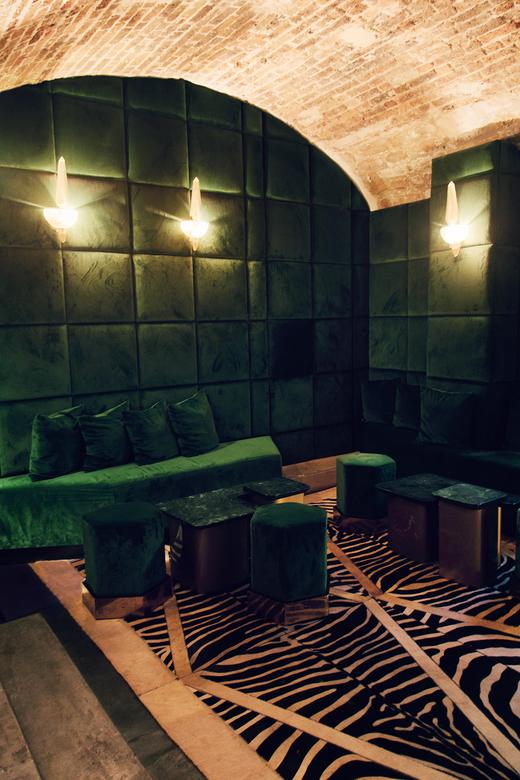
“Serpent à Plume is a space where bright ideas, desires and incessant journeys meet in the oldest square in Paris: the Place des Vosges. Nothing here is real. Everything is allowed, or almost everything… In the simplest apparel, in pyjamas or an evening gown. Alone, with your gallery owner friend, or with your lover. Adventure awaits you!”
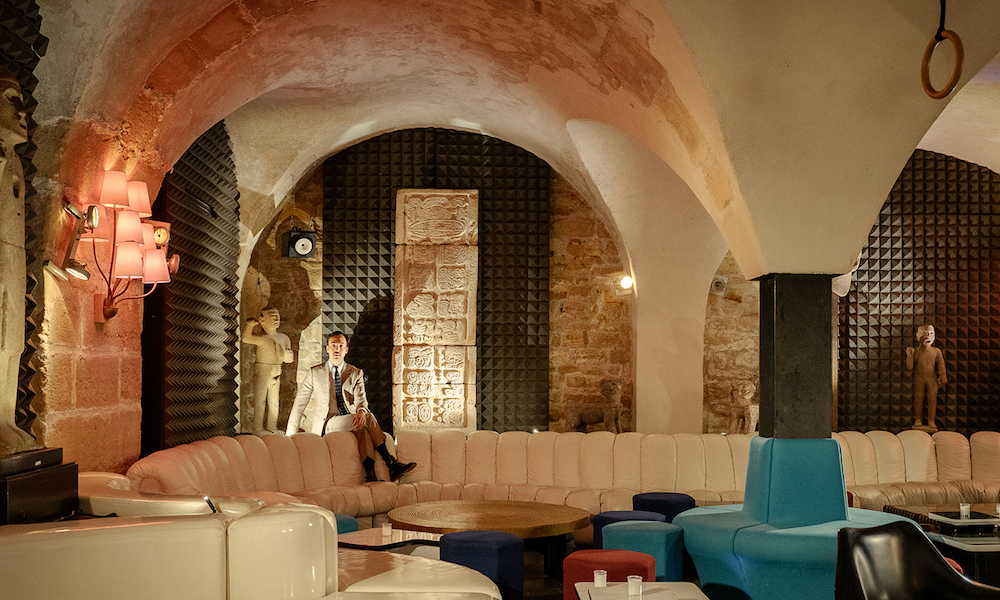
In the basement, sometimes adorned with dark green velvet, sometimes vaulted in stone, the large white leather Sede sofa unfolds like a snake basking under the rocks. “It is the centerpiece, in my opinion, of the Serpent. The first one I acquired at auction, too, before I even knew what I was going to open! Her organic side corresponds in all respects to this project, moreover… It seems that she is telling us ‘go with the flow.”
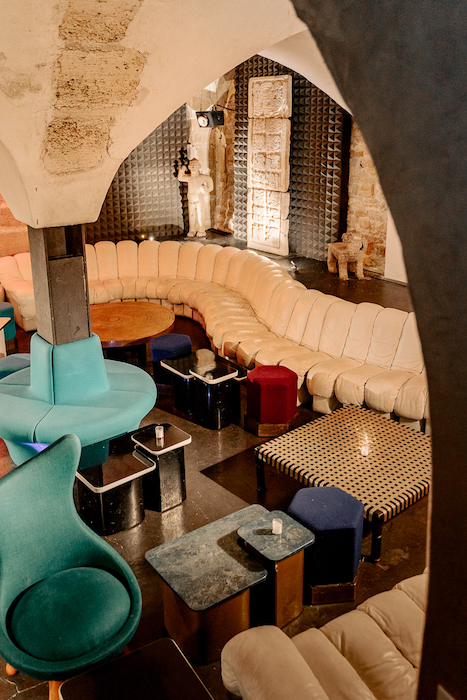
Serpent à Plume without “s”. Alexander Keyes Rash says, “There are two reasons for this: first, I am American, so I make mistakes. Then, I found it more aesthetic, more impactful . “Always this attention to detail. The feathered serpent was an important deity in my mythology. It translates the influence that pre-Columbian art had on me. And then, of course, he is the god of the underworld. It represents our style well, here… Our different strata of life.”

“In the dreamy half-light of the salons of a beautiful red brick building with limestone ties so specific to the Place des Vosges, primitive art, 18th century canvases, Art Nouveau furniture and 1970s design mingle with pomp, passion and irreverence. Each floor develops its own range of atmospheres, sometimes baroque, always unique, reflecting the enthusiasm and the activity of the hosts who enliven it. The address is indeed the playground of a collective of art-loving aesthetes.”
I can’t wait to stop by the next time I am in Paris while figuring out how I can get invited upstairs!
Bon week-end!
XOXO,
HC

